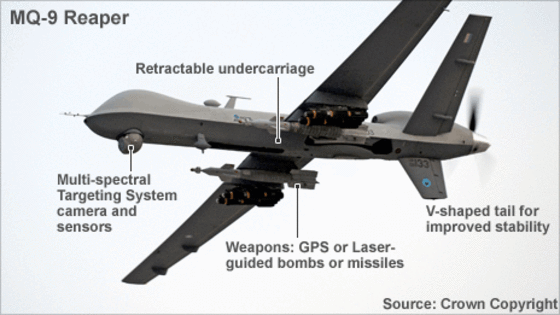We are at the peak of inflated expectations about drones. So many people are hyped up, in one way or another, about what drones are capable of delivering to us: pizzas and burritos, missiles and railguns, fun and thrill, political debates and Federal Aviation Administration (FAA) meetings, etc to the point that how drones themselves have been brought to us is mostly overlooked. Now, having explored the current state of the art, it may be a good time to ponder over how drones have been delivered to us by the media, as filmmakers and news reporters have painted the drone scene with just about every brush and hue there is.
The first scenes of the 2014 film Interstellar picture a solar-powered surveillance drone that has been rendered useless after a decade-long flight. The film depicts this drone as a rather passive agent, remotely hacked and brutally dissected with its batteries plucked out. Here, it is a given fact that drones do not change people’s lives. In fact, it is the people that tweak the drone to make it suit whatever purpose they deem appropriate. In contrast, the 2015 film Eye in the Sky portrays a drone as a life- changing agent. In this film about the US drone strikes in Kenya, it is only natural that a drone is a means of espionage and assault and that there is nothing that people would do to change that; instead, it alters fates as it poses life-and-death situations to unsuspecting civilians and a series of questions, requests, reports, and approvals up and down multiple chains of command to military officials.

These are only two of the many examples; the rise in popularity of drones has manifested in their appearance in a number of other recent, commercially successful films. Drones equipped with face recognition and target-neutralizing webs hover to track down Matt Damon in Elysium, and a fully armed UAV is remotely controlled from the other side of the planet to kill Jeremy Renner in Bourne Legacy. Dozens of drones appear in The Tunnel, a Korean satirical film released earlier this year, to carry out search-and-rescue operations for a person buried alive under the debris of a fictional, collapsed tunnel. Tom Cruise works as a technician that repairs damaged combat drones that guard a hypothetical, ruined Earth in Oblivion. What essentially appear to be armed, human-form-factor drones whizz around and launch projectiles in Iron Man 3 and X-Men: Days of Future Past.
The sheer variety of media’s portrayal of drones is none less overwhelming in the news media than it is in the art of filmmaking. Any magazine from Smithsonian — yes, as in the Smithsonian museums — to WIRED and any daily from Wall Street Journal to Bangkok Post that comes up on the Google News search results has reported something about drones in the last 24 hours at the time of writing this article. What is more is the variety of viewpoints presented: governments’ worries about the lack of drone regulations, businesspeople’s concerns over excessively tight regulations, researchers’ interests in drone applications for ocean and space exploration, military officials’ arms race for seizing a more advanced espionage technology, manufacturers’ market domination and platform establishment tactics, developers’ setup and customization how-to guides, families’ hype over which drones to buy their kids, and more. The multi-faceted applications of drones have been so overtly laid out altogether that they may be eclipsing the equally multi-faceted implications of the technology. With multiple stakeholders battling their way for or against drones, the average Joe is left ever more baffled as to which perspective to enthrone.
On one hand, it could be a relief that laypeople in general have not yet arrived at a consensus over what drones really mean to them, but a prolonged, indecisive stance towards a fast-approaching technology could also mean that there awaits a great deal of confusion about how to, if at all, let the technology become an integral part of everyday life as some developers so claim. Just as guns and computers have first been thought to be so useful, only to be accompanied later by an exhaustive array of precautionary measures, drones might just as well have to undergo an extensive process of protocolization and standardization by regulatory bodies. Indeed, in a world where drones can still be thought of as both hovering lifeguards and covert assassins at large, the sky may be too high a limit.

